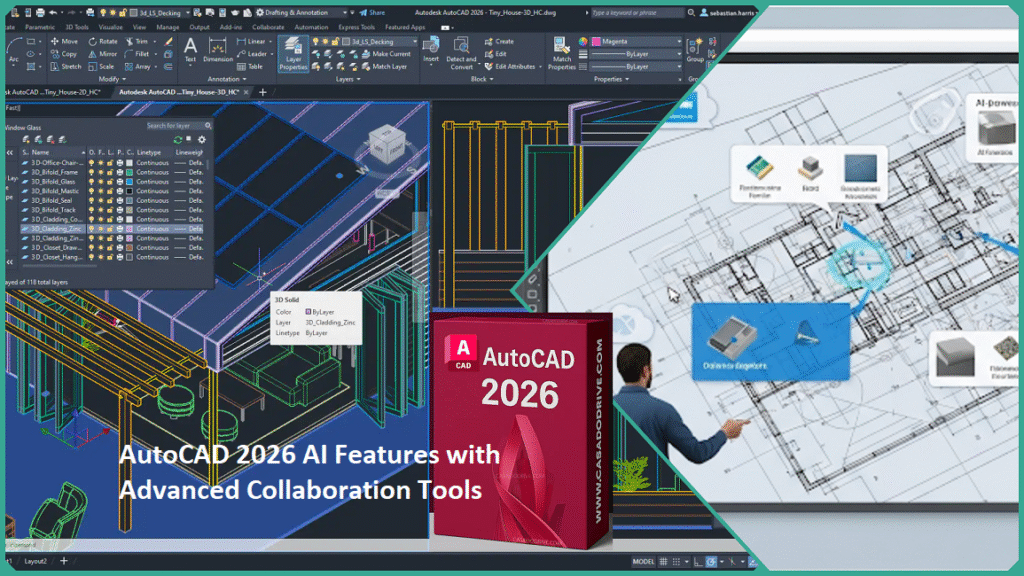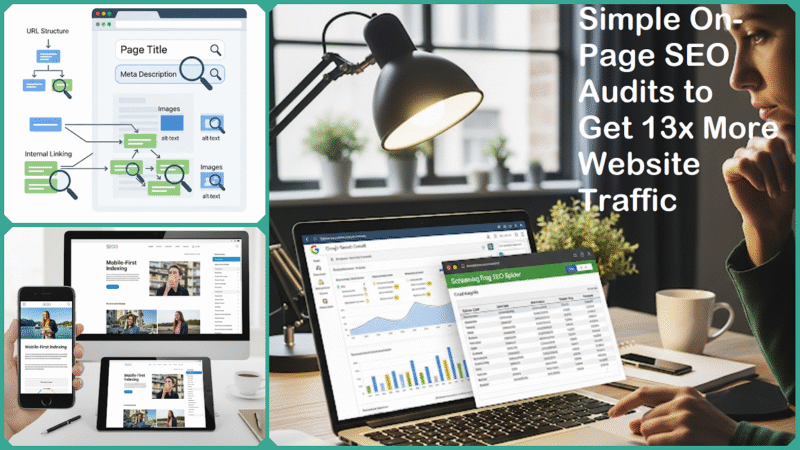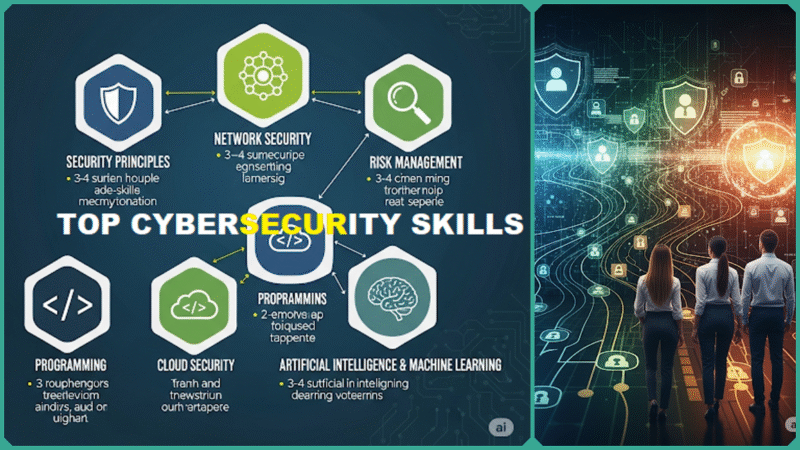AutoCAD 2026 AI Features with Advanced Collaboration Tools
Estimated reading time: 26 minutes
AutoCAD 2026 isn’t merely an update—it represents a significant and bold leap forward designed to empower engineers, architects, designers, CAD managers, educators, and decision-makers working across the diverse fields of AEC (Architecture, Engineering, Construction) as well as the manufacturing industry. This latest release brings a host of advanced features and improvements aimed at enhancing productivity, streamlining workflows, and supporting innovative project development in these critical sectors.
Packed with breakthrough AI-powered automation features and a wide array of sophisticated collaboration tools, the latest version of AutoCAD is specifically engineered to address and solve real-world bottlenecks that many professionals face daily. It significantly reduces repetitive tasks, enhances the organization of complex drawings, and unlocks seamless coordination among team members, making project management smoother and more efficient.

For anyone who is deeply invested in achieving the highest levels of design excellence and is also focused on optimizing operational efficiency to its fullest potential, AutoCAD 2026 stands out as an incredibly powerful and versatile tool. It unquestionably demands a thorough, detailed, and close examination to fully appreciate its extensive capabilities and the significant impact it can have on your projects and workflows.
Understanding the Core Concepts in AutoCAD 2026
Artificial Intelligence in Computer-Aided Design (CAD) is fundamentally transforming the way designers engage with their drafting and modeling tools. In the latest release, AutoCAD 2026, AI is far more than just a trendy term or marketing slogan; it embodies a set of practical, deeply integrated features that significantly enhance and streamline the entire design workflow by:
Smart Prediction
AutoCAD 2026 is equipped with advanced AI capabilities that enable it to thoroughly analyze the context of your current drawing. By understanding the elements you have already placed, it can intelligently anticipate what you are likely to add next.
For instance, if you are in the process of drafting a detailed floor plan and you insert a door, the AI might proactively suggest adding common wall fixtures, such as light switches or electrical outlets, or other relevant architectural features close to the door.
This thoughtful assistance greatly enhances your efficiency and helps accelerate your entire design workflow, making the drafting process smoother and more intuitive.
Natural Language Commands
Instead of having to navigate through multiple complicated menus or trying to memorize a wide range of complex commands, users can now simply type or speak their design instructions using everyday, natural language. For example, by saying “Draw a 12-foot by 10-foot room with a window on the east wall,” AutoCAD is able to automatically generate the precise geometry required.
This innovative feature effectively bridges the gap between the user’s intent and the actual execution of the design, making the entire process much more intuitive and efficient.
Intelligent Pattern Recognition
This refers to the advanced capability of AI to thoroughly scan and analyze a drawing, identifying repeated elements or blocks that may appear throughout the design. The AI then assists in organizing these components or cleaning up inconsistent and outdated legacy files that can often be difficult to manage manually.
For instance, if there are numerous similar symbols present with only slight variations, the AI can intelligently suggest standardizing these into a single, unified block. This process not only ensures greater uniformity across the entire drawing but also helps significantly reduce errors and improve overall efficiency in the design workflow.
Machine Learning for Standards and Consistency
By intelligently learning from user behavior patterns and adapting to project-specific standards, AutoCAD 2026 significantly enhances the ability to maintain strict drafting consistency throughout the design process. It automates many routine and repetitive tasks, such as dimension placement or the application of annotation styles, by leveraging past user preferences and established company standards.
This not only helps in minimizing the likelihood of human error but also considerably saves valuable time, allowing designers to focus more on creativity and complex problem-solving rather than manual adjustments.
Key Benefits:
- Automates repetitive and time-consuming tasks to significantly free up designers, allowing them to focus more on creative work and innovative projects.
- Significantly reduces errors that commonly arise from inconsistencies in manual drafting processes, ensuring greater accuracy and uniformity throughout the project.
- Makes CAD software more accessible and user-friendly by incorporating intuitive commands that simplify the design process and enhance overall usability.
- Enhances overall productivity by providing intelligent and insightful suggestions that streamline tasks and optimize workflow efficiency.
Collaboration Tools in AutoCAD 2026
Design projects nowadays frequently involve numerous contributors who work either asynchronously or simultaneously, often spanning various geographies and diverse disciplines. AutoCAD 2026’s advanced collaboration tools are specifically designed to bridge these gaps effectively by empowering teams with a comprehensive set of features that enhance communication, streamline workflows, and ensure seamless coordination throughout the project lifecycle.
These tools enable smoother interaction and more efficient teamwork regardless of location or time differences:
Real-Time Co-Authoring
Multiple users can work simultaneously on the very same DWG file, allowing for true real-time collaboration. Any changes made by one user are immediately visible to all other collaborators, ensuring everyone stays up to date with the latest modifications.
Additionally, the system includes advanced built-in mechanisms designed to handle and resolve potential conflicts that may arise when multiple edits occur at once. This thoughtful conflict management enables teams to work together smoothly and efficiently, eliminating common version control issues and headaches that often disrupt collaborative workflows.
Granular Feedback Integration
Team members and stakeholders have the ability to directly add detailed markups, comments, and annotations right within the drawing using Autodesk Docs and the Trace feature. This functionality effectively eliminates the need for disconnected feedback loops that often occur through email or separate software tools, ensuring that all revisions and comments remain fully centralized and easily accessible in one location.
Activity Tracking and Insights
AutoCAD 2026 offers comprehensive session-level tracking capabilities that clearly document who made specific changes and how each drawing has progressed and evolved. This enhanced transparency is invaluable for project managers, enabling them to maintain a high level of accountability throughout the entire design process.
Additionally, it significantly streamlines the review process by allowing for faster and more precise evaluations, ensuring that every modification is thoroughly understood and appropriately addressed.
Cloud-Native Support Files
Fonts, templates, plot styles, and a wide variety of other essential support files are automatically synchronized through Autodesk Docs’ robust cloud platform. This seamless synchronization guarantees that all team members and collaborators are consistently using the most current and up-to-date resources available. As a result, this process significantly reduces the chances of discrepancies and errors, while greatly enhancing the level of standardization and uniformity across various teams and projects.
Cross-Platform Access
Whether using a desktop computer, a tablet, or a mobile device, users have the ability to access and edit drawings seamlessly, as well as add comments or review markups with ease. This level of flexibility is essential in supporting the hybrid and remote work models that have become increasingly common and necessary in today’s fast-evolving industry landscape.
Key Benefits:
- Significantly enhances overall productivity by minimizing the need for excessive back-and-forth communications, allowing tasks to be completed more efficiently and with greater focus.
- Ensures that all team members remain fully aligned by providing a single, reliable source of truth that everyone can refer to consistently throughout the project.
- Facilitates much quicker and more efficient decision-making processes by providing instant and immediate feedback at every stage.
- Supports distributed teams by enabling seamless cloud-based collaboration, allowing members to work together efficiently regardless of their physical locations. This cloud-enabled approach enhances communication, file sharing, and project management, ensuring that teams stay connected and productive no matter where they are situated around the world.
In Summary
In sum, AutoCAD 2026’s integration of AI transforms traditional CAD from a manual, repetitive task into a smarter, more intuitive design experience that learns and adapts to user behavior. Meanwhile, its advanced collaboration tools empower modern multi-user workflows with real-time coordination and cloud-driven resource management.
For users, this powerful combination translates to significantly less time wasted on repetitive chores and frustrating version conflicts, allowing them to dedicate much more of their valuable time to innovation, precise design accuracy, and effective teamwork. As a result, teams can deliver stronger, higher-quality project outcomes at a much faster pace, enhancing overall productivity and success.
What’s New in AutoCAD 2026?
AutoCAD 2026 introduces an impressive range of powerful new AI-driven features along with advanced collaboration tools, all thoughtfully designed to significantly save time, enhance precision in every aspect of design, and greatly improve team workflows for a more seamless and efficient project experience.
AI Features That Save Time and Enhance Precision
- Smart Blocks: Detect & Convert: With AutoCAD 2026, advanced AI technology is employed to thoroughly scan entire drawings, intelligently identifying and grouping repeated geometry and objects automatically throughout the design. This innovative feature enables users to quickly convert these detected groups into precise block definitions, which greatly minimizes the need for manual cleanup and effort. As a result, it helps users efficiently standardize legacy files and maintain consistency across complex projects with much less time and hassle than before.
- Smart Blocks: Search & Convert: Users can search through their drawings to identify repetitive objects, text, or variable text elements and then convert these into either existing blocks or create entirely new blocks. This powerful automation significantly streamlines the management of symbols, facilitates the efficient placement of common fixtures, and greatly accelerates the overall drafting process, making it more efficient and less time-consuming.
- AI-Powered Design Assistant: By continuously learning from individual user workflows and adapting to their specific design habits, this intelligent assistant is able to predict the most logical next steps in a project. It suggests relevant design elements, including common features like typical door placements in detailed floor plans, and automates the addition of annotations. This comprehensive support not only helps users maintain a high level of accuracy throughout their work but also significantly speeds up repetitive and time-consuming tasks, enhancing overall productivity.
- Natural Language Commands: You can now effortlessly type or speak detailed design instructions using plain, everyday English, such as “Add a 10′ x 12′ room with a North wall window.” AutoCAD will intelligently interpret your words and automatically generate the corresponding geometry, effectively bridging the gap between your initial design intentions and the actual execution process with ease and precision.
- Intelligent Dimensioning: By effectively leveraging contextual information and analyzing user habits, AutoCAD 2026 is able to intelligently identify and select the most relevant measurement references. This advanced capability ensures that dimensions are not only accurate but also remain consistent across all aspects of your projects, enhancing overall precision and workflow efficiency.
- Activity Insights & “What’s Changed”: Our enhanced tracking system now offers detailed monitoring of edits, markups, and changes, delivering comprehensive session-level insights across multi-user projects. This improvement significantly simplifies the process of identifying exactly who made which changes, allowing teams to quickly pinpoint contributions. As a result, review cycles become much faster and more efficient, with clear accountability established for every modification made during the project timeline.
Practical Impact
For instance, a CAD technician who is tasked with designing and refining complex hospital floor plans can significantly reduce the time spent on tedious manual corrections. By utilizing the Smart Blocks: Detect & Convert feature, the technician can automate the process of identifying duplicated symbols and inconsistent blocks.
This automation not only saves hours that would otherwise be dedicated to fixing these issues but also enhances the overall accuracy of the drawings. As a result, the project experiences fewer errors, and the total time required for completion is greatly decreased, allowing for more efficient workflow and faster delivery.
Advanced Collaboration Tools
- Real-Time Co-Authoring: Multiple team members have the ability to simultaneously edit a single DWG file, with changes being updated live in real time. This feature includes intelligent conflict resolution mechanisms that ensure smooth and efficient collaboration, preventing any version conflicts or data loss during the editing process.
- Multi-User Markups: Multiple stakeholders and team members can easily annotate and provide detailed comments directly on drawings through the use of Trace layers. This collaborative feature ensures that all feedback is continuously synced and updated in real-time to the main project file, significantly reducing the usual delays and bottlenecks commonly experienced during project review phases.
- Connected Support Files: Fonts, plot styles, and templates are seamlessly synchronized automatically across all projects through Autodesk Docs, ensuring consistent application of company-wide standards. This automatic syncing process significantly helps reduce errors and inconsistencies, making project management more efficient and reliable throughout the organization.
- Markup Import & Markup Assist: Effortlessly import markups from a variety of file formats, including PDFs, JPGs, and PNGs, directly through Autodesk Docs. Advanced AI technology assists by consolidating multiple revisions, streamlining the review process, and intelligently suggesting the most effective next steps to quickly identify and resolve any issues that arise. This powerful combination enhances collaboration and accelerates project timelines.
- Enhanced Activity Insights: Managers can now closely monitor and track every change made throughout the entire project cycle. They can easily see who made specific edits and gain a clear understanding of how these modifications impact the overall progress. This feature is especially vital and beneficial for distributed teams working remotely or across different locations, ensuring seamless coordination and accountability.
- Integrated Communication Hub: Featuring built-in commenting, task assignments, and comprehensive review tools, this hub significantly streamlines communication directly within AutoCAD. By centralizing these functions, it effectively reduces the need for numerous external emails and frequent meetings, allowing teams to collaborate more efficiently and maintain seamless project workflows.
- Cross-Platform Access: Users have the ability to begin their work seamlessly on desktop computers, then continue making edits on tablets, and finally review their progress on mobile devices. This is all made possible through real-time synchronization, which ensures that all changes are instantly updated across every device. This feature supports highly flexible workflows, whether users are working remotely from different locations or on-site within the same office environment.
Industry Example
An innovative architectural firm with offices spread across several major cities significantly shortened the time required to complete and finalize detailed floor plans by implementing advanced real-time co-authoring tools and enabling multi-user markups.
This transformation streamlined their traditionally lengthy feedback and revision process, which used to take an entire week, reducing it dramatically to just a single day, thereby increasing overall efficiency and client satisfaction.
Performance and Workflow Optimizations
- Experience up to 11 times faster file opening and an impressive 4 times quicker startup when working with large DWG files, allowing you to spend significantly less time waiting and much more time focusing on creative designing.
- The accelerated graphics engine significantly enhances the overall user experience by providing much smoother navigation and faster rendering speeds, especially when handling complex 3D models. This improvement is particularly beneficial for projects that involve intricate mechanical designs or are heavily focused on visual detail, allowing for more efficient workflow and better visualization.
- Custom Toolsets 2.0 enable the creation and sharing of organization-wide automation routines and user interfaces, significantly enhancing workflow consistency across teams and departments. These advanced toolsets empower users to streamline processes and ensure standardized operations throughout the entire organization.
Specialized Toolsets & Cloud Integration
- Industry-specific enhancements tailored for architecture, mechanical, electrical, and civil engineering disciplines now feature significantly expanded smart content libraries along with advanced tools specifically designed to support every stage of the design and documentation process. These improvements aim to streamline workflows and enhance precision throughout project development.
- The seamless integration with Autodesk Docs guarantees that all drawings, markups, and supporting files remain consistently up to date and are easily accessible for every member of the team at all times. This integration helps streamline collaboration and ensures that everyone is working with the most current information without any delays or confusion.
This comprehensive overview of AutoCAD 2026 highlights a major and significant advancement in AI-assisted drafting and collaboration technologies, specifically designed to greatly boost productivity, minimize errors, and streamline team workflows across a wide variety of diverse industries and professional sectors.
Current Trends & Industry Impact
AutoCAD 2026’s impact on the industry reflects significant and rapidly evolving current trends, particularly the integration of AI-driven automation and the widespread adoption of cloud-native collaboration tools, which are fundamentally reshaping the way design professionals work, communicate, and deliver complex projects efficiently.
These advancements are not only enhancing productivity but also enabling more innovative and seamless design workflows across various sectors.
AI-Driven Automation Transforming CAD Workflows
AutoCAD 2026 integrates AI features that have moved beyond novelty to become essential tools for improving productivity and design quality. These include AI-powered drafting assistance, automated block management, and intelligent dimensioning. Industry reports and expert analyses underscore how AI-driven capabilities streamline drafting standards enforcement, accelerate project review cycles, and reduce human errors.
For example, Gartner and other technology research entities consistently emphasize “intelligent automation” and “AI in AEC design” as pivotal factors driving efficiency gains and error reduction across architecture, engineering, and construction workflows.
AutoCAD 2026’s AI learns user preferences and project contexts, automating routine but time-consuming tasks such as detecting duplicate blocks, standardizing symbols, smart annotation, and dimension placement.
This directly translates to significant time savings—activities that once took hours can now be completed in minutes—freeing CAD users to focus on higher-value design work. Reduced errors from consistent AI-assisted standards also mitigate costly rework and client revision cycles.
Cloud-Native Collaboration Enhances Teamwork and Project Integrity
Modern design projects are increasingly distributed across remote teams and involve numerous collaborators working from different locations, making seamless cloud integration an essential operational necessity for successful project management.
AutoCAD 2026 extensively uses Autodesk Docs along with various cloud services to function as a centralized hub where project files, markups, and workflows are efficiently managed and accessed, ensuring smooth collaboration and streamlined communication among all team members.
Key collaboration enhancements include:
- Real-time co-authoring and multi-user markups, enabling simultaneous work and instant feedback without versioning conflicts.
- Activity tracking and audit trails, including features like “What’s Changed,” which help CAD managers and decision-makers maintain accountability and project integrity across distributed workflows.
- Automatic syncing of support files such as fonts, plot styles, and templates, which enforce company-wide standards and reduce errors caused by inconsistent resources.
These features effectively address several common pain points encountered in remote collaboration by seamlessly consolidating communication channels and feedback loops directly within AutoCAD’s environment. This integration significantly reduces the length and complexity of review cycles, thereby accelerating the overall decision-making process and enhancing team productivity.
Practical Industry Value: Time, Accuracy, and ROI
The combination of advanced AI automation technologies and seamless cloud-based collaboration provides numerous tangible benefits and advantages, including:
- Time Savings: Repetitive tasks like block conversion, standard enforcement, and markup consolidation now take minutes rather than hours, accumulating project time savings measured in days monthly for teams.
- Error Reduction: AI-assisted drafting combined with synchronized team feedback drastically reduces missed inputs and undocumented revisions, lowering risks of costly rework.
- Improved ROI: Both SMBs and large enterprises benefit financially from fewer mistakes, faster project completions, and improved client satisfaction. The streamlined coordination fosters better resource utilization and project delivery reliability, justifying investment in AutoCAD 2026 upgrades or subscriptions.
Industry and Market Context
AutoCAD 2026 is designed to reinforce Autodesk’s position as a leader in the highly competitive CAD software market by closely aligning with the most important current industry trends. By fully embracing advanced artificial intelligence capabilities and enhanced cloud collaboration tools, the platform remains exceptionally competitive and appealing when compared to other strong competitors such as BricsCAD and ARES.
While the new AI-powered features promise to deliver significant productivity improvements and streamline design workflows, Autodesk also openly recognizes that users and organizations may face a learning curve as they adapt to these innovations. Additionally, there are ongoing considerations regarding subscription costs, which may impact the overall adoption and budgeting decisions for many users and companies alike.
Comparison of AutoCAD 2026 with Earlier Versions
Here is a comprehensive and detailed comparison table that highlights and explains the key differences and improvements between AutoCAD 2026 and AutoCAD 2025, based on the most recent and authoritative sources available in the industry:
| Feature Area | AutoCAD 2025 | AutoCAD 2026 (New) |
|---|---|---|
| File Opening Speed | Standard file open time | Up to 11x faster file opening on average, especially noticeable with large 2D & 3D DWG files |
| Program Startup Speed | Standard startup time | Up to 4x faster application launch, reducing wait and improving workflow efficiency |
| Smart Blocks | Placement only (automatic placement based on previous insertions) | Enhanced Detect & Convert: AI scans and groups repeated geometry to convert into blocks automatically, improving legacy file cleanup and standardization. Also includes Search & Convert features powered by AI |
| Collaboration | Basic Autodesk Docs linking | Advanced: Real-time co-authoring, project-aware connected support files, multi-user markups, and integrated communication tools. Enables seamless distributed team workflows |
| Change Tracking | Manual DWG Compare | Enhanced “What’s Changed” activity insights with detailed session-level tracking, version comparison, and accountability features across multi-user projects |
| Markup Assist | Import markups from files (PDF, JPG, PNG) | Direct import from Autodesk Docs with AI-powered suggestions and actions to consolidate revisions faster and more accurately |
| Mobile-Desktop Experience | Partial synchronization | Fully synchronized workflows across desktop, web, tablet, and mobile apps with real-time edits and comments syncing |
| Industry Toolsets | Standard content libraries | Expanded discipline-specific features and smart content libraries for architecture, mechanical, electrical, and civil workflows |
| Performance Enhancements | Standard graphics engine and processing | Accelerated Graphics System Fabric (GSF) uses GPUs and multicore CPUs for smoother rendering in complex 3D models. Custom Toolsets 2.0 for enhanced automation |
| Connected Support Files | Not project-aware; manually shared | Project-aware connected support files (fonts, hatches, templates) sync automatically across teams via Autodesk Docs, enforcing standards and reducing errors |
AutoCAD 2026 delivers substantial and impressive performance upgrades—including dramatically faster file openings and significantly reduced startup times—and ushers in next-level AI features such as Smart Blocks Detect & Convert and an advanced AI-powered markup assist tool.
The collaboration ecosystem evolves beyond simple file linking to include real-time co-authoring and multi-user feedback, all fully synchronized and seamless across multiple platforms. These major advancements focus on streamlining workflows, significantly reducing repetitive tasks, minimizing errors, and providing robust support for distributed teams, making it far more efficient and user-friendly than AutoCAD 2025.
Best Practices for Leveraging AutoCAD 2026
Here are the best practices for leveraging AutoCAD 2026 effectively, carefully aligned with your outlined points and thoughtfully enriched with industry-recommended strategies to help maximize your efficiency and productivity in every project you undertake:
- Explore Smart Blocks: Detect & Convert for Legacy Cleanup and Standardization
- Use the Detect & Convert AI feature to scan existing drawings and automatically group repeated geometry into blocks. This cleans up legacy drawings quickly and enforces uniform standards across projects, reducing errors and speeding revisions.
- Regularly update your block libraries to reflect common project elements and encourage reuse across teams, enhancing consistency.
- Integrate Markup Import & Trace to Centralize Feedback
- Leverage AutoCAD 2026’s ability to import markups directly from Autodesk Docs (PDFs, JPGs, PNGs) and consolidate feedback using AI-powered Markup Assist. This keeps all comments, revisions, and annotations within the CAD environment, eliminating fragmented review cycles.
- Use Trace layers for collaborative annotation, enabling stakeholders and team members to comment directly on drawings in real time, making feedback transparent and actionable.
- Educate Teams on New Collaboration Workflows
- Develop a structured training program to familiarize users with AI-enhanced tools and advanced collaboration features like real-time co-authoring, multi-user markups, and Activity Insights.
- Offer hands-on workshops and create quick-reference guides focusing on how to best utilize these features in daily workflows to ensure smooth adoption and reduce transition challenges.
- Customize Toolsets with Company-Specific Macros and Templates
- Implement Custom Toolsets 2.0 to develop automation routines and UI customizations tailored to your organization’s unique processes. This boosts productivity and enforces drafting standards across projects.
- Standardize templates, including layers, dimension styles, linetypes, and title blocks embedded with project-specific parameters to reduce setup time and maintain consistency.
- Monitor Projects Using Activity Insights
- Use Activity Insights and “What’s Changed” features to track edits, who made changes, and design evolution across multi-user projects. This enhances accountability and helps managers quickly review progress and identify potential bottlenecks.
- Integrate these insights with project management tools where possible to maintain alignment between design activities and overall project timelines.
- Encourage Cross-Platform Usage for Flexibility
- Promote using AutoCAD across desktop, tablet, and mobile platforms to facilitate on-site markups and remote reviews, enabling real-time synchronization and reducing delays.
- Ensure your team is equipped and trained on the mobile and web apps of AutoCAD, empowering users to engage in design and collaboration anytime, anywhere.
Additional Recommended Practices
- Establish Clear CAD Standards and Naming Conventions: Define and enforce consistent layers, block naming, file naming, and dimensioning protocols to avoid confusion and ensure coherent project documentation.
- Utilize Cloud-Based Collaboration Platforms: Fully embrace Autodesk Docs and BIM 360 integrations for secure file sharing, version control, and centralized project data, ensuring all team members use the most current drawings and support files.
- Implement Version Control and Backup Procedures: Use systematic version labeling and regular backups to protect against data loss and to maintain a clear history of design revisions.
- Leverage Shared Libraries and Blocks: Maintain centralized libraries of frequently used blocks and components, regularly updated to deploy the latest standards and facilitate efficient drafting.
- Optimize File Management: Organize project files logically, with clearly categorized folders and controlled access permissions to improve retrieval and control sensitive data.
- Standardize Communication Channels: Establish dedicated communication platforms integrated with AutoCAD workflows (e.g., Microsoft Teams, Slack) for project discussions, feedback, and task assignments to streamline coordination.
- Provide Ongoing Training and Support: Ensure continuous skill development with periodic training sessions, user support, and resources to keep teams updated on new features and best practices.
By diligently following these recommended best practices, teams can significantly maximize the productivity gains, enhance collaboration efficiencies, and improve design accuracy offered by the advanced features of AutoCAD 2026.
At the same time, they can effectively minimize any potential adoption friction that might arise during the transition process, ensuring a smooth integration of the software into existing workflows. This approach also helps maintain consistent project quality across all stages of design and implementation, ultimately leading to better outcomes and more successful project completions.
FAQs
How does AutoCAD 2026’s AI improve drafting productivity?
AutoCAD 2026’s AI features learn your design habits and workflows to automate repetitive tasks such as block detection and conversion, intelligent dimensioning, and annotation automation. It offers smart predictions to suggest the next drawing steps and enables natural language commands to draft designs from plain English inputs. These AI-driven tools reduce manual edits and cleanup, allowing you to focus on creative design intent rather than routine operations, significantly speeding up your drafting process.
Does the new collaboration suite work with non-Autodesk cloud platforms?
The advanced collaboration tools in AutoCAD 2026 are optimized around Autodesk Docs and the Autodesk ecosystem for real-time co-authoring, connected support files, and multi-user markups. While you can still import and export drawings to and from other cloud platforms like Dropbox or Google Drive, the sophisticated real-time collaboration features and activity tracking require Autodesk Docs integration to function fully.
Can multiple team members edit a drawing at once with AutoCAD 2026?
AutoCAD 2026 supports real-time co-authoring that allows multiple users to simultaneously edit the same DWG file. The system includes intelligent conflict resolution to maintain data integrity and safeguards against conflicting changes. This feature facilitates efficient distributed teamwork and multi-firm collaboration without version control issues.
Are the AI features suitable for all disciplines (architecture, mechanical, electrical)?
The AI features like Smart Blocks (Detect & Convert) and intelligent dimensioning provide broad benefits. They are especially valuable for projects with repetitive geometry and standard elements, such as architectural floor plans. Mechanical, electrical, and civil engineering users gain from enhanced industry-specific toolsets, accelerated graphics performance for complex 3D models, and customized automation workflows. Thus, AutoCAD 2026’s AI capabilities adapt well across various disciplines.
What hardware or setup is needed to maximize AutoCAD 2026’s AI and collaboration features?
To harness the full performance and AI capabilities, AutoCAD 2026 benefits from modern hardware with strong GPUs and multi-core CPUs, which accelerate file openings, rendering, and AI computations. For collaboration features, a robust and stable network connection is crucial, alongside an Autodesk Docs subscription for real-time cloud integration and multi-user collaboration. These setups ensure smooth operation of both AI-driven tools and cloud-based teamwork.
In Conclusion
AutoCAD 2026 truly sets a remarkable new industry benchmark by seamlessly combining powerful AI-powered automation features with a comprehensive suite of advanced collaboration tools. This innovative integration delivers significant and tangible improvements in productivity, accuracy, and teamwork for design professionals working across a wide range of disciplines.
Here’s why upgrading to or adopting AutoCAD 2026 represents a highly strategic and forward-thinking move for professionals and businesses alike:
- Significant Performance Gains: Up to 11× faster drawing file openings and 4× quicker startup times let you spend more time designing and less time waiting, especially for large or complex projects.
- Intelligent AI Features: Smart Blocks detect and convert repeated geometry automatically, natural language commands simplify drafting, and AI-powered design assistants streamline annotations and dimensioning—all saving substantial manual effort and reducing errors.
- Next-Level Collaboration: Real-time co-authoring, multi-user markups via Trace, and project-aware connected support files synchronized through Autodesk Docs facilitate seamless, transparent teamwork across locations and devices.
- Cross-Platform Flexibility: Fully synchronized workflows across desktop, web, tablet, and mobile empower users to work and review designs anytime, anywhere, supporting modern hybrid or remote work environments.
- Improved Project Control: Activity Insights and “What’s Changed” features provide granular visibility into edits and version histories, enabling better accountability and faster review cycles.
To fully harness and maximize these valuable benefits:
- Upgrade or start a trial to explore firsthand how AutoCAD 2026’s AI and collaboration tools fit your workflows and project demands.
- Invest in team training to ensure all users can leverage new features confidently and efficiently, minimizing disruptions during the transition.
- Adopt a cloud-centric project management approach centered on Autodesk Docs to maintain data consistency, streamline feedback, and support real-time collaboration.
If you’re ready to completely transform your design processes by embracing smarter drafting techniques, achieving faster overall performance, and enabling seamless collaboration and teamwork, you should consider requesting a free, no-obligation demo or reaching out to an authorized Autodesk partner.
These valuable resources are designed to help your organization thoroughly evaluate the potential return on investment (ROI) as well as the practical impact that AutoCAD 2026 can have on your specific workflows and project outcomes, ensuring you make an informed decision tailored to your unique needs.
This powerful combination of enhanced speed, advanced intelligence, and seamless collaboration perfectly embodies Autodesk’s forward-thinking vision for the future of computer-aided design (CAD). It firmly establishes AutoCAD 2026 as an exceptionally compelling and valuable upgrade for design professionals who are eager to maintain their competitive edge and stay at the very forefront of cutting-edge design innovation and technological advancement.
Discover more from Skill to Grow
Subscribe to get the latest posts sent to your email.






